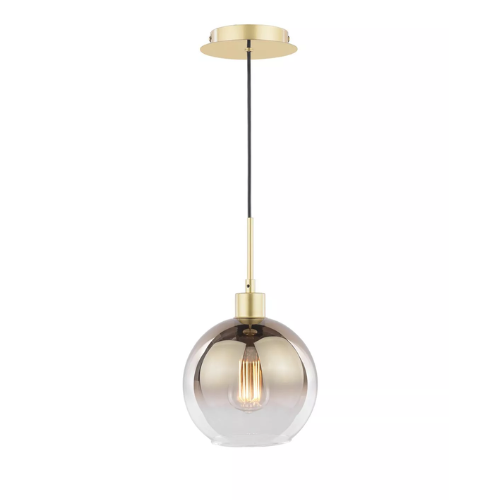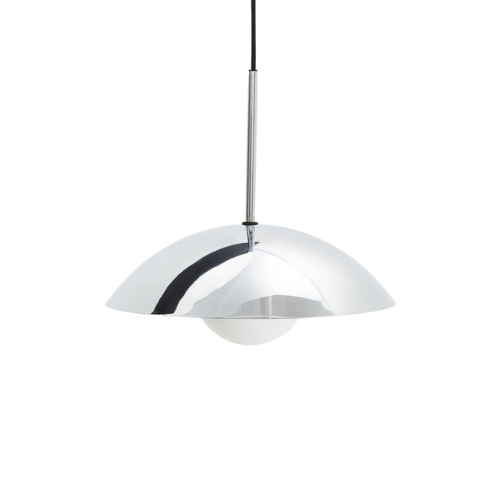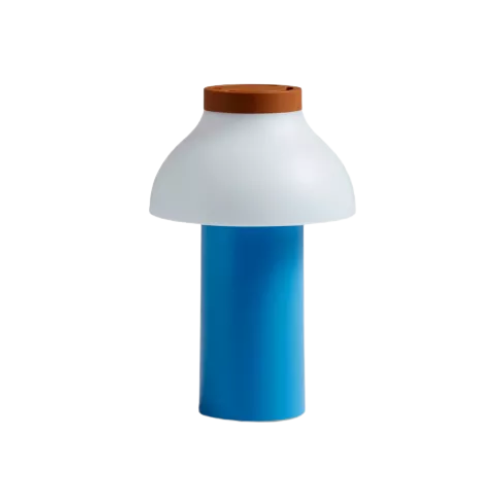7 Budgeting Mistakes to Avoid When Planning Your Kitchen Extension
Designing a kitchen extension on a strict budget requires you to work smarter, not harder. Avoiding these slip ups is the first step to success.
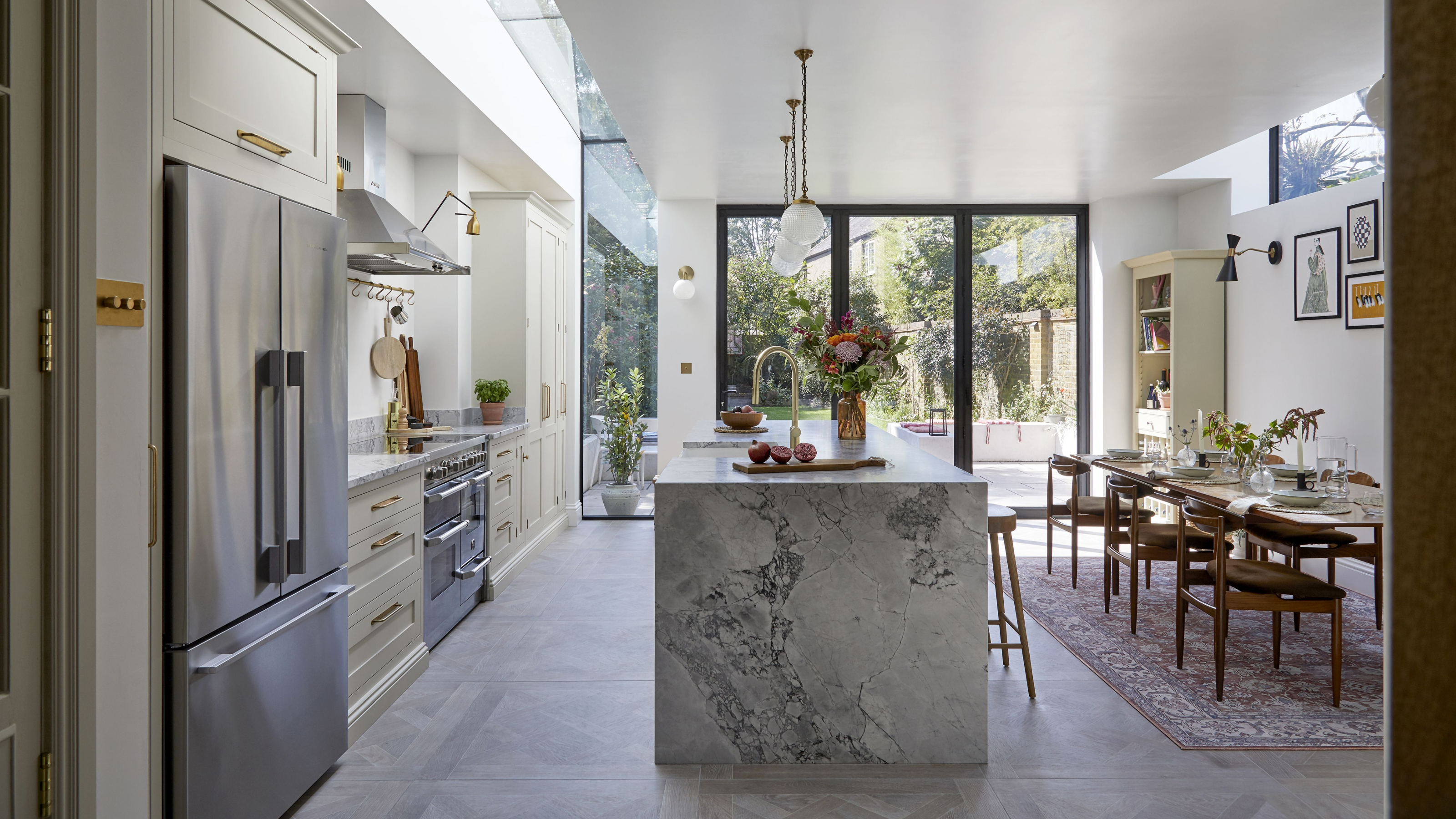

Attempting to design a kitchen extension without breaking the bank can feel like a minefield. No aspect of the process feels particularly pocket-friendly, and it can be hard to know where to skimp and where to splurge when every element feels so crucial.
"When designing a kitchen extension on a budget, it’s crucial to prioritise the elements that will stand the test of time," says Louisa Eggleston, Humphrey Munson’s Creative Director. Investing in high-quality workmanship at the beginning of building your dream kitchen extension idea will save you from years of constant repair work, meaning you'll be saving money in the long term. Splashing out on a showy marble countertop that you'll have to constantly worry about maintaining may be a less sensible use of your budget.
Identifying your priorities will be the most helpful first step for ensuring you don't blow your budget and then regret it. The kitchen is such a personal space, and we all use it in different ways. Figuring out your expectations from the space and investing your money in ways that will reflect these expectations will allow you to build a space that is functional, beautiful, and budget-friendly.
But we understand that this may still feel slightly overwhelming. That's why we've consulted our experts, asking them about the biggest mistakes you can make when designing your kitchen extension on a budget, so you know what to avoid.
1. Forgetting to Pre-Plan
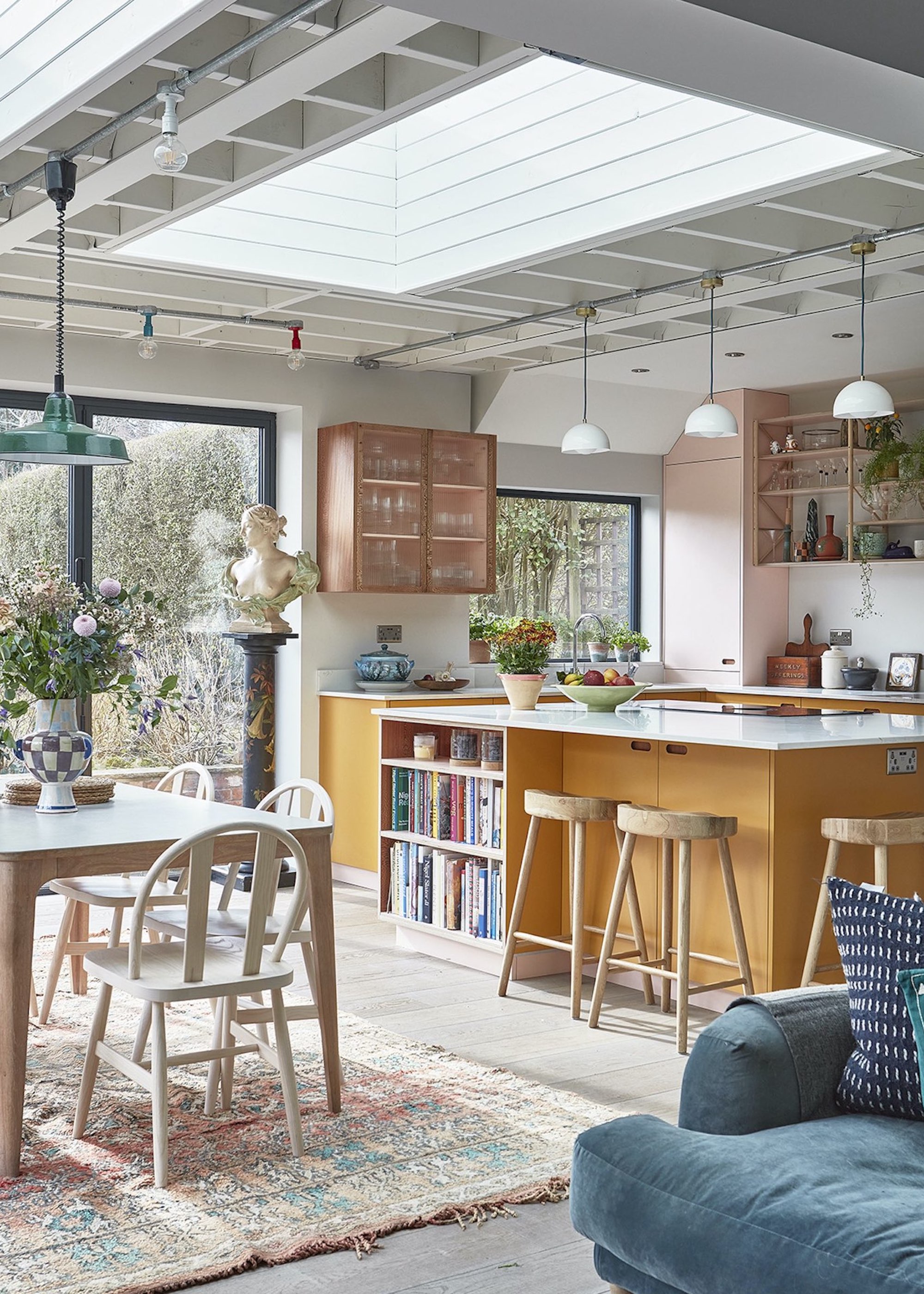
Before construction, figure out your color palette by using paint samples, sometimes you can be surprised by the colors that work alongside each other.
The number one piece of advice that any expert, luxury or budget alike, will give you is this: get ahead of the game. Nick Duggan, from The Radiator Centre, says, "Start early. Planning in advance will always save time and money at the end."
The earlier you begin the process of planning your kitchen extension, the more likely you are to be sure you're getting the best deal possible, from the best people for the job.
This approach will also allow you to build a more considerate, detail-oriented kitchen design that reflects the people who will use it. When you're working under a tight time-limit, it becomes increasingly easy to race into decisions, not stopping to consider whether or not this will even be a useful addition to your home, or if it will be worth the price tag attached.
"Taking the time to define your goals, budget, and must-haves before any work begins will set a strong foundation for a smooth renovation," suggests Claire Garner, from Claire Garner Design Studio. "Consider how you use your kitchen daily and ensure your design supports your lifestyle."
As most people who've planned an extension will tell you, it will always take longer than you initially think or, than you are initially told. As Molly Chandler, designer at Willis and Stone, says, "Any structural work and alterations to electric and plumbing, will require a lot of planning ahead and timescales can vary greatly depending on the project."
Even if your builders have assured you that your kitchen will be ready to be cooking in after a quick 3 months, don't be surprised if you find yourself waiting round for them to finish for an extra couple of months. "However, for the kitchen design itself, try to allow 3-4 months from the first design appointment to the installation, this gives you plenty of time to consider your choices make sure the kitchen works perfectly for you," explains Molly.
With over 15 years’ experience in the interior design industry, and over a decade running her own interior design studio, Claire Garner is a certified expert in all things design. She believes in designing spaces which are tailored specifically for her clients, gaining an understanding of how they live their life and want their home to look and feel.
Claire has a BA in Textile Design, and has become known for her unique balance of texture and tonal colour schemes – creating beautiful designs through layered simplicity; evoking a true sense of depth and calm in her spaces.
2. Trying to Cutting Corners
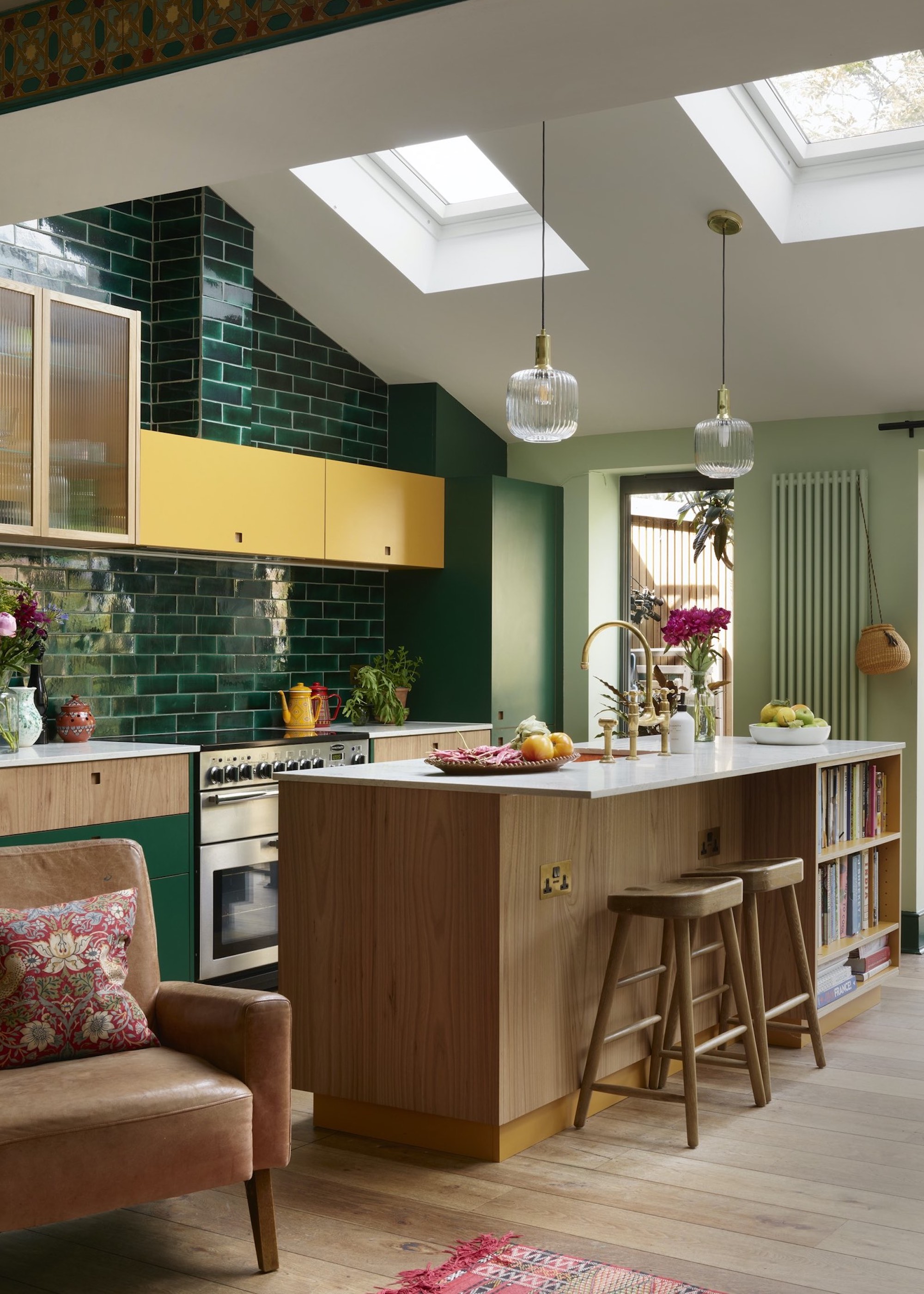
Avoid cutting corners as it could just cost you more.
We understand the temptation, trust us, we do, but ultimately, if you choose to work with cheap craftsmen, the likelihood is your home will look just that — cheap. "An experienced designer will not only help you create a functional and beautiful space but also guide you through the process, avoiding costly mistakes and delays. Their expertise will ensure your layout, storage, and finishes work together harmoniously," explains Claire.
Lisa Hensby, from Hensby Homes, agrees, saying, "Picking the wrong people for the job can also be a costly mistake. Poor workmanship means paying twice to get it fixed. And don’t forget to set aside a bit of a buffer — a contingency fund is a lifesaver when the unexpected happens (and it usually does!)."
Equally, if a price sounds too good to be true, it probably is. It may seem smart at first to spend less on a cheaper material, but when you're having to shell out hundreds every month just to try keep it running, you'll end up spending more in the long-run.
As Nick says, "Quality does count for a lot." He continues, "Something might appear disproportionately expensive, but there is usually a very good reason. It will come down to the quality of the materials, the finish and the service you would undoubtedly be receiving from the supplier. What might appear cheap on the initial budget sheet might prove costly in the long term."
A higher price tag typically aligns with a higher standard of quality, which means your kitchen will last longer. This, however, doesn't mean you have to blow the budget on a marble surface or a state-of-the-art fridge. In fact, the best option is often somewhere in the middle of the road, not the cheapest and definitely not the most expensive.
Researching high-quality marble alternatives will allow you to create that same luxurious look, at a more approachable price point. Plus, these alternatives are often more durable than the real deal.
3. Not Lighting Up Your Space Properly
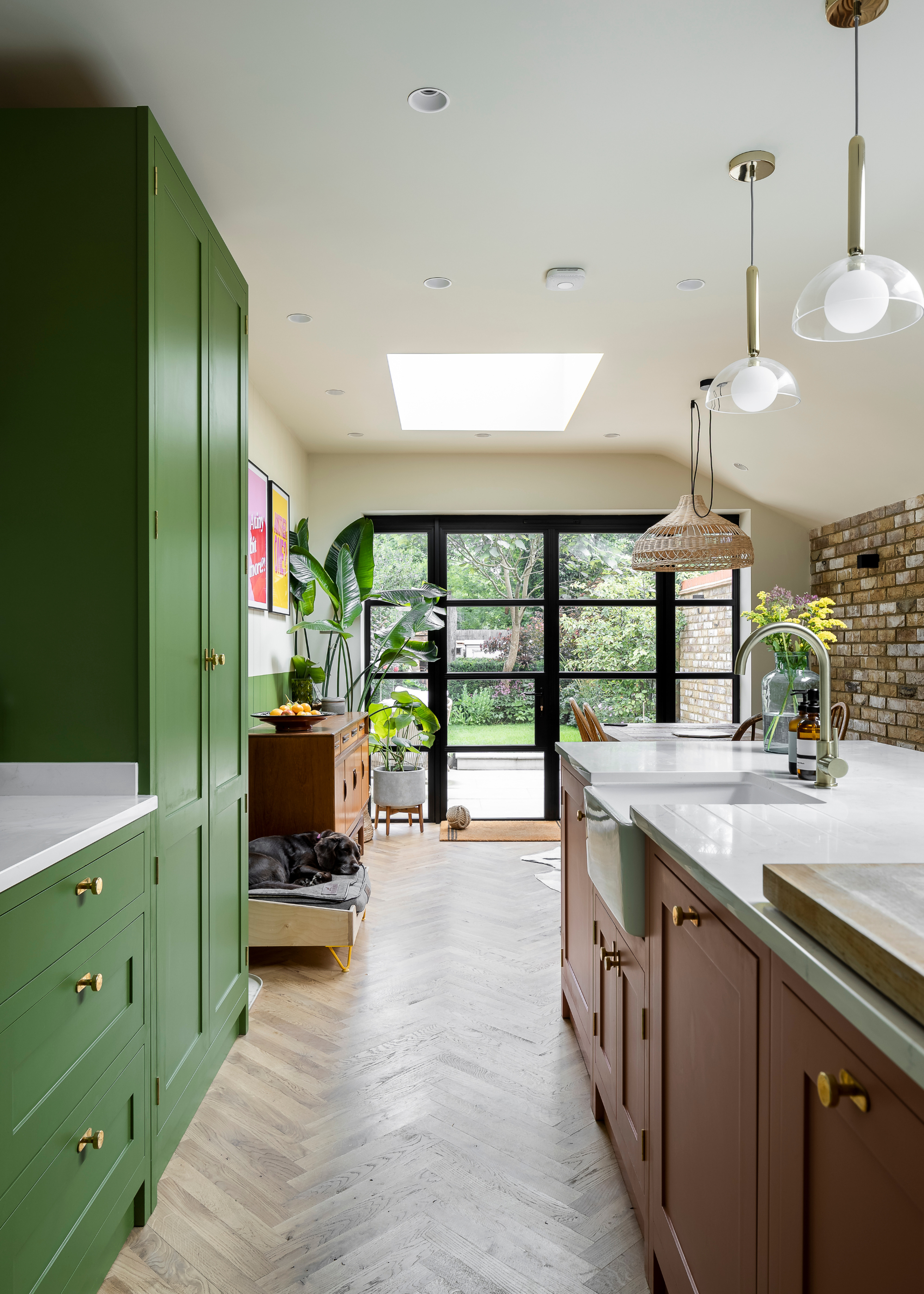
Pendant lights over your kitchen island add a modern, contemporary feel.
When trying to save money when designing a kitchen, lighting is often the first thing to get knocked off the priority list. It makes sense; the best kitchen lighting ideas are costly, and good lighting doesn't feel integral to a functional, beautiful kitchen.
How wrong this assumption is. Without adequate lighting, the entire kitchen becomes a struggle to use. "One of the most frequent mistakes in kitchen lighting design is failing to provide adequate task lighting, which can result in poorly lit workspaces that make food preparation difficult and even hazardous," comments James Kendall, from KES Lighting.
Simple tasks, like chopping an onion, can quickly become disastrous without proper lighting. Lighting is also the key to creating an inviting atmosphere in your kitchen. "Many homeowners also rely too heavily on recessed ceiling lights, which, when used alone, can create harsh shadows and fail to provide sufficient illumination in key areas," adds James.
Harsh overhead lighting is not only unflattering but also unappetizing. Just as a cold overhead light makes you look your worst, it will do the same for your food, putting a serious dampener on all those dinner parties you had planned. "Another common oversight is the lack of dimmable lighting, which significantly limits the flexibility of the space. Incorporating dimmers allows for lighting to be adjusted according to different needs, whether it’s bright illumination for cooking or softer lighting for dining," says James.
4. Not Being Realistic and Practical
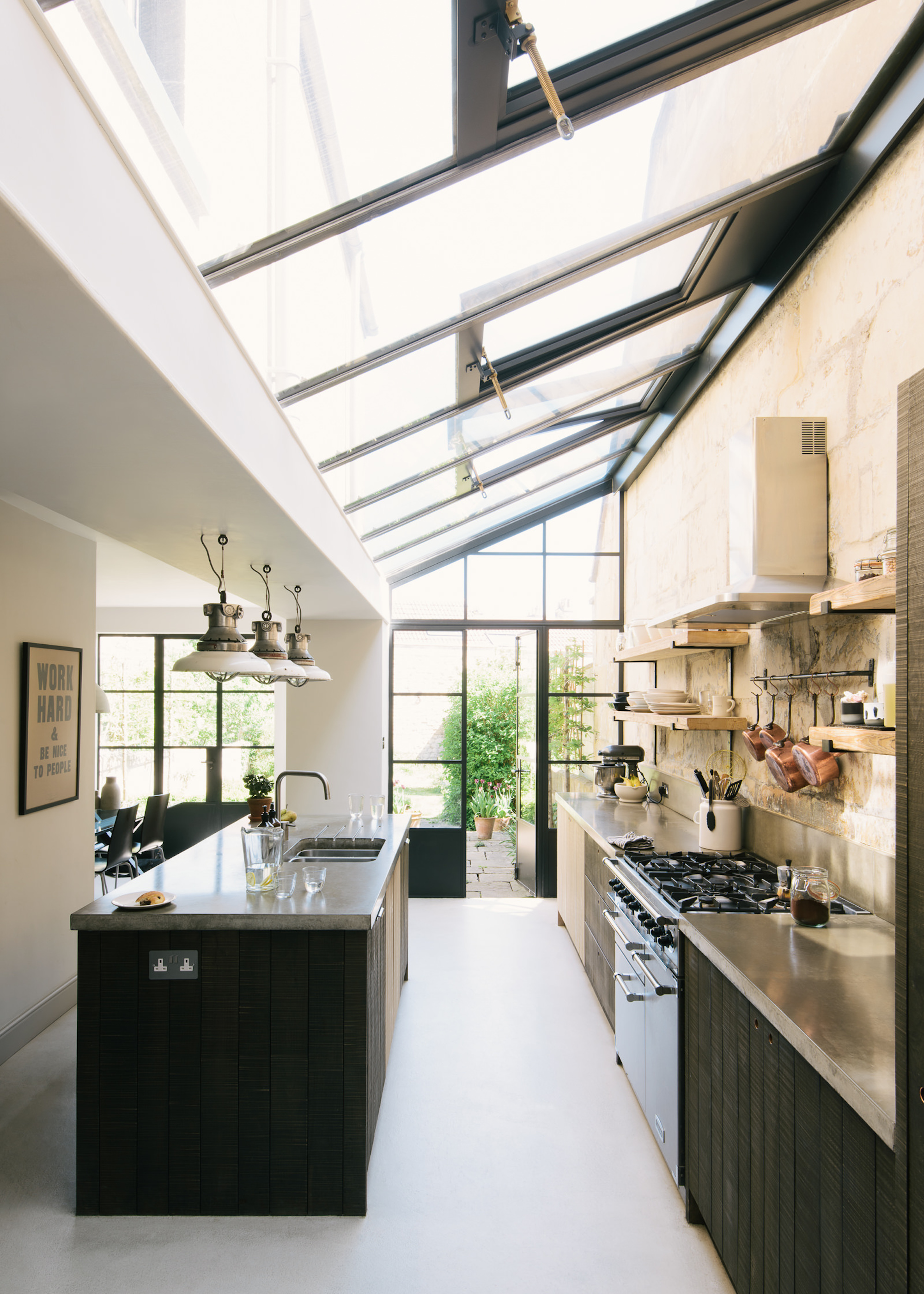
Your layout should reflect the way in which you'll use your space.
It can be easy to get carried away, swept up in a haze of all your dream modern kitchen ideas, but the reality is, there are more important things to invest in than the surface finishes. "There’s always the temptation to go a bit overboard with fancy features," says Lisa, "lovely as they are, they can send your budget spiralling."
Instead, she suggests, "Keep things simple and practical — the more complicated the design, the more likely you’ll run into expensive structural work or pricey custom features. If you can, stick with the existing layout, especially for plumbing and electrics. Moving that stuff around can really add up."
Trying to maintain as much of the existing structure and plumbing as possible will help simplify the process, cutting downs on costs and on time. "Try to avoid sacrificing functionality for style; prioritize practicality in your design choices to create a kitchen that not only looks great but also meets your everyday needs," recommends Molly.
While it's important to love the look of your kitchen, don't let this override the importance of loving the feel of your kitchen. This is a space you'll need to use every day, so ensuring its functionality and utility are the best they can possibly be should be your highest priority.
5. Not Knowing Where to Invest
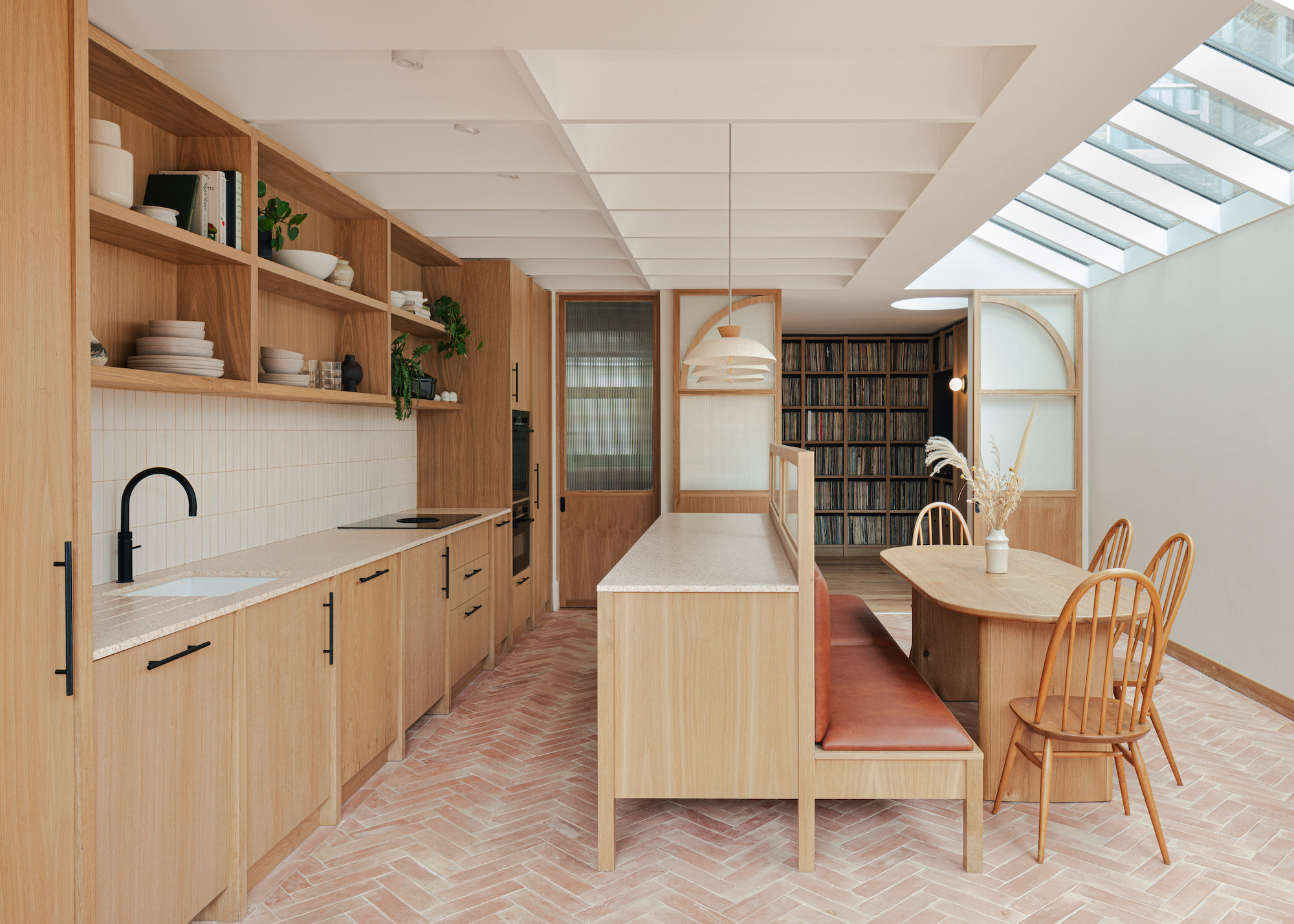
Open shelving can help add character to your space, giving you the opportunity to showcase your crockery.
"One of the most worthwhile investments you can make is in high-quality cabinetry and a well-considered layout," says Louisa. Knowing where you should be spending your money is one of the best things you can do for your kitchen extension while maintaining your budget. "Good design is the ultimate form of future-proofing - if the flow, functionality and structure of the kitchen are right, you can always refresh the aesthetic later with new paint colours, handles, or lighting."
Louisa continues: "But if the layout doesn’t work, or the cabinetry starts to deteriorate, you’re back to square one, and likely at a much higher cost. Well made cabinetry not only lasts longer but also adds value to your home, both in day-to-day living and eventual resale. In short, spend wisely at the start and get the bones of the space right and to avoid costly regrets down the line."
As Louisa mentions, cheap cabinetry will wear down more quickly, and the upkeep needed to make them look presentable will add up, making them more expensive in the long-term.
Lisa explains, "Cheap materials for things like cupboards and flooring might save money upfront, but they tend to wear out quickly and need replacing sooner than you’d like."
Your kitchen cabinetry fulfils more than just a functional purpose, they also help build the overall feel and aesthetic of your space, and the choices you make regarding storage will have a huge impact on your kitchens look. Ash McCullough, from Blakes London, says, "Not all storage is created equal, and sometimes, more doesn’t necessarily mean better."
While it can be tempting to load up on kitchen storage ideas, this can end up making your space seem clunky. "In some cases, sacrificing a bit of storage in favour of a decorative shelf or open space can greatly enhance the overall look and feel of your kitchen. If you’re opting for overhead storage, make sure it’s genuinely necessary, rather than simply filling the space for the sake of it."
Ash says drawers tend to be more expensive, "they are often more practical and user-friendly than cupboards, making your kitchen more functional. When planning your layout, think about what you need to store and how often you access those items—this will help guide your decisions on which storage options to prioritise for the best balance of functionality and aesthetics."
While studying Interior Architecture and Design at the University of Essex Ashe developed a love for color and texture that she has kept with her throughout her career. She honed these skills working for a bespoke joinery studio in Ireland where she designed traditional style kitchens, dressing rooms and furniture for luxury properties. After a move to London, Ash spent three years as a sales designer for an interior design studio. Now, at Blakes London, Ash takes her clients through the whole process, from design to completion, bringing her expert knowledge to every design.
6. Trying to Do it All
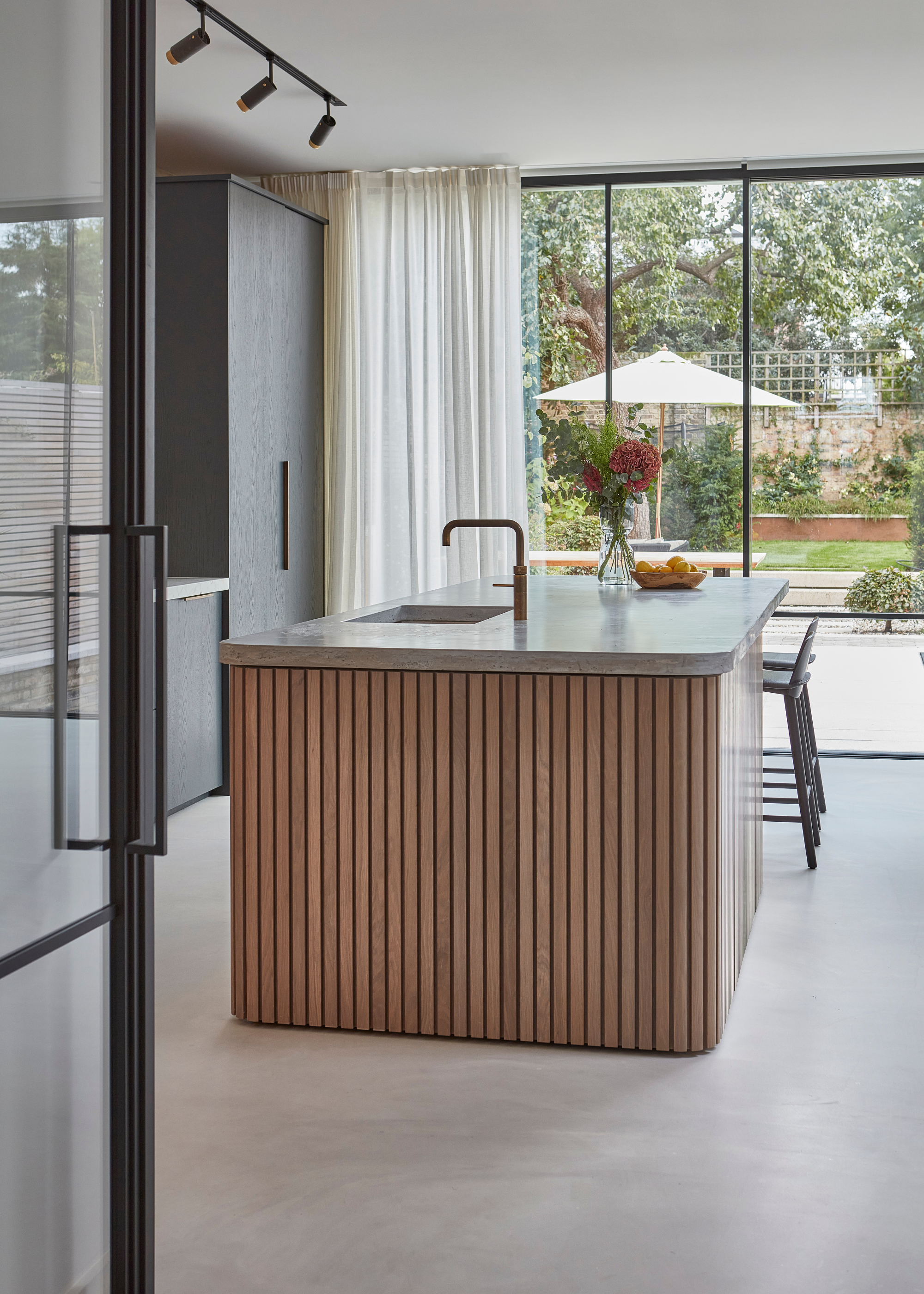
A pared-back design creates a more relaxing atmosphere.
Accepting and embracing some limitations when designing your kitchen extension can ultimately help you design a more sleek, cohesive space. "The biggest mistake people often make is trying to cram too many ideas into one space, whether that’s about functionality or aesthetics. If in doubt, our mantra is less is more," says Ash.
Focusing on the essential non-negotiables and adopting a more relaxed approach to every element that doesn't fall into that category is the ideal philosophy to follow when planning your kitchen extension.
"The most common issue we see is people trying to fit a kitchen, dining area, and some form of soft seating into one room. Often, this results in each area being less than optimal. In many homes, there’s a separate lounge area in another part of the house that ends up being underused, so it’s always worth considering the extension in the context of the overall use and flow of the entire home," Ash explains.
Similarly, trying to combine multiple, contrasting interior design styles can end up looking more of a mish-mash than maximalist. "One common mistake is attempting to mix too many different styles in the same space. If you’re drawn to a variety of ideas and styles that don’t naturally align, create a mood board to see how these elements work together," Ash suggests.
"Eclectic design can be wonderful, but it’s important not to overdo it. Visualising everything on a single board allows you to assess how well the different elements form a cohesive scheme," adds Ash.
7. Not Having a Budget Buffer
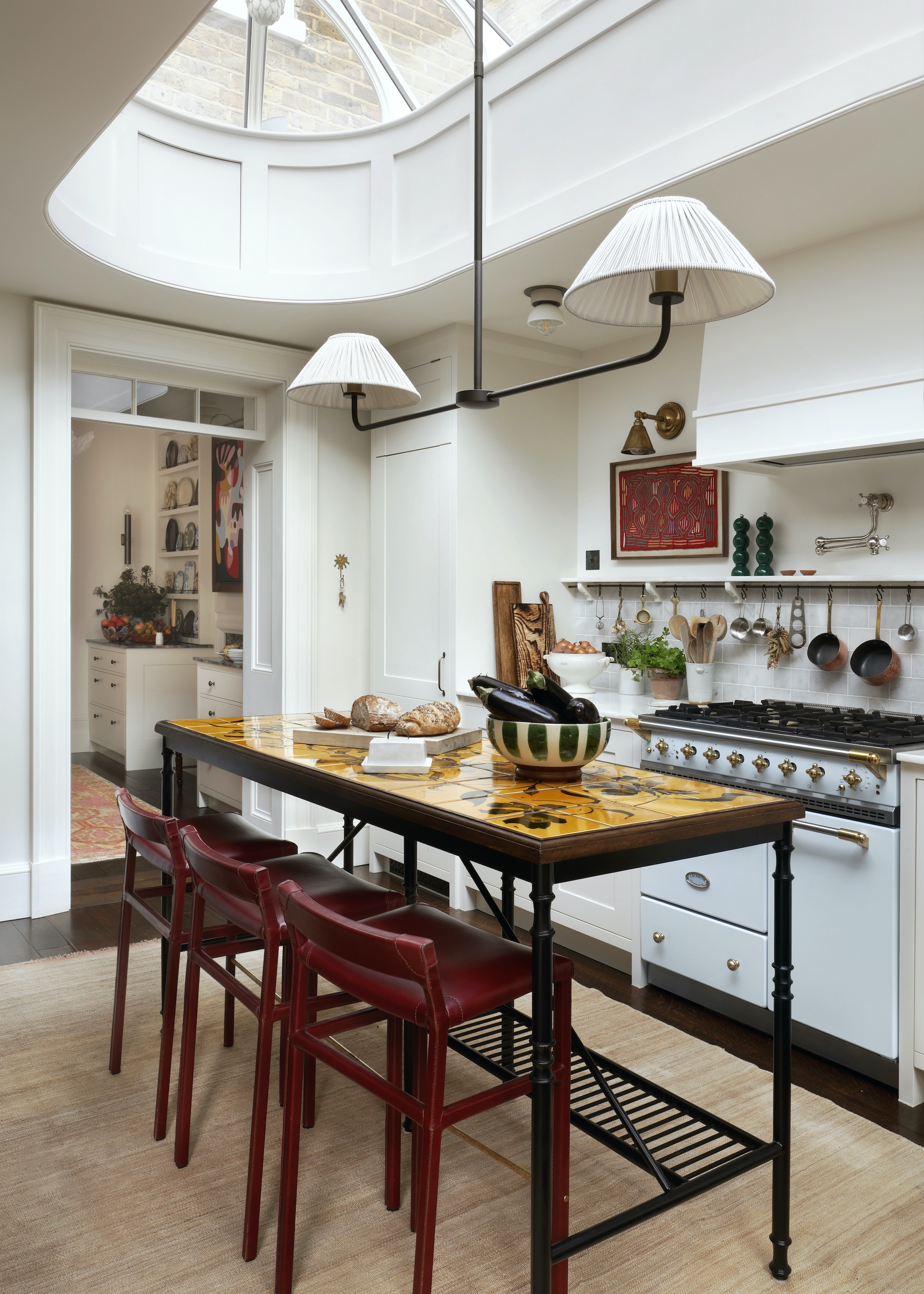
Finding some items second-hand, like bar stools and accessories, can help cut down costs, saving your budget for the structural work.
While you may think you know how much your extension is going to cost, there are always some sneaky hidden costs ready to jump out and surprise you. This is why having a reserve of funds is so important.
As Al Bruce, founder of Olive and Barr says, "The cost can vary depending on many factors which include size, structural work, quality of materials and more, don’t forget that there can be hidden costs, which is why it’s always worth including a contingency within your budget."
Having a little extra to fall back on when designing your kitchen extension minimises the potential for disaster, making the process less stressful. Ash also emphasizes the importance of having a contingency budget, saying, "Budget management is another area where mistakes can occur. People often spend a significant portion of their budget upfront on the architecture and structure of their extension, leaving insufficient funds for the fit-out or for a buffer in case the build uncovers unexpected cost overruns."
Mapping this out at the very beginning, before you get into the bulk of the construction, can help you feel more secure as you head into the building process. "The structural elements of the extension are typically where unforeseen costs arise, so without a buffer, the budget often gets squeezed from the fit-out—the part of the extension you’ll live with and see every day," says Ash.
FAQs
How Can I Stay on Budget for a Kitchen Extension?
Even the most luxurious kitchen designers have picked up some tips over the years for keeping the costs lower. After all, finding ways to save means that there's more to spend on the important parts. "Open shelving, for example, can be a stylish and cost-effective alternative to banks of wall cabinets - and it can actually make the space feel lighter and more open," suggests Katerina Tchevytchalova, Director at K’Arte Design.
She continues, "You can also find good deals on appliances if you shop around or wait for promotions, and it’s always worth seeing if anything from your existing home can be reused, like internal doors, radiators, or even furniture."
Lisa also learned the importance of finding a good deal, saying, "Keep an eye out for seasonal sales or times when contractors might offer off-peak discounts. Staying organized, being flexible, and focusing on what truly adds value will help you create a gorgeous, practical kitchen without blowing the budget."
She continues, "For worktops and kitchen flooring, you don’t need to splash out to get something stylish and hard-wearing — laminate and vinyl can look fab and hold up well too. Let in as much natural light as you can, and use LED lighting to help trim the energy bills. And don’t underestimate the power of a good deal — budget-friendly taps, handles and fittings (especially if they’re on sale!) can really lift the space without blowing the budget."
Now you know how to keep the costs down, it's time to get into the more exciting part. A budget-friendly kitchen by no means needs to be a boring kitchen. With endless new kitchen trends to explore, there are no shortage of interesting ideas to bring into your extension.
Be The First To Know
The Livingetc newsletters are your inside source for what’s shaping interiors now - and what’s next. Discover trend forecasts, smart style ideas, and curated shopping inspiration that brings design to life. Subscribe today and stay ahead of the curve.

Maya Glantz is a Design Writer at Livingetc, covering all things bathrooms and kitchens. Her background in Art History informed her love of the aesthetic world, and she believes in the importance of finding beauty in the everyday. She recently graduated from City University with a Masters Degree in Magazine Journalism, during which she gained experience writing for various publications, including the Evening Standard. A lover of mid-century style, she can be found endlessly adding to her dream home Pinterest board.
-
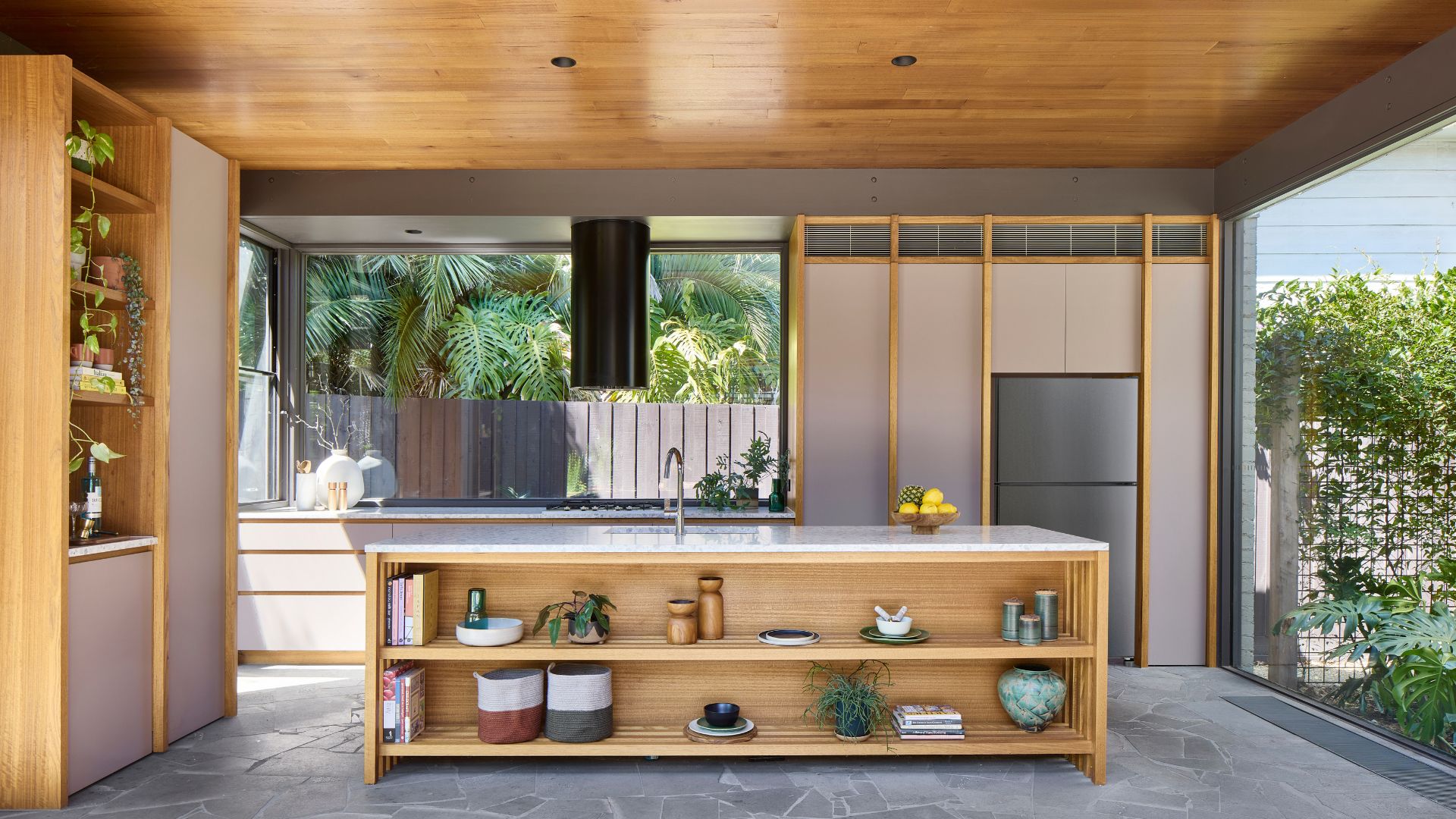 Biophilic Decluttering — What to Take Out of Your Home (and What to Put in) for a More Natural Home
Biophilic Decluttering — What to Take Out of Your Home (and What to Put in) for a More Natural HomeTry your hand at biophilic decluttering to ground your interiors, connect to the environment, and cure chronic clutter in one go. Here's how.
By Amiya Baratan
-
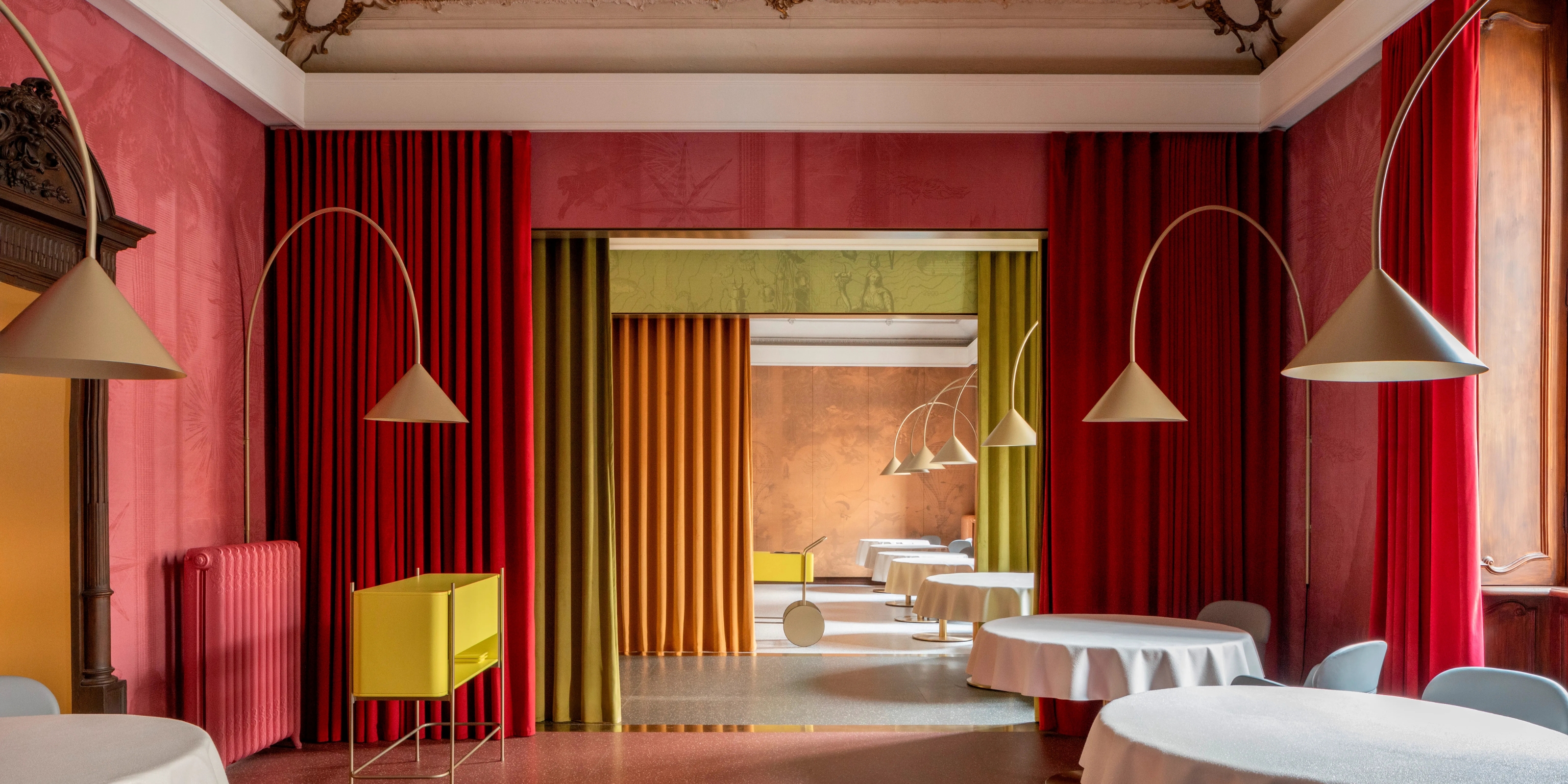 10 Arrestingly Beautiful Milan Restaurants Locals *Actually* Dine at — Selected for Their Interiors
10 Arrestingly Beautiful Milan Restaurants Locals *Actually* Dine at — Selected for Their InteriorsBrought to you by our community of culture insiders, this edit of the best restaurants in Milan sees authentic Italian food and immersive design unite
By Gilda Bruno
-
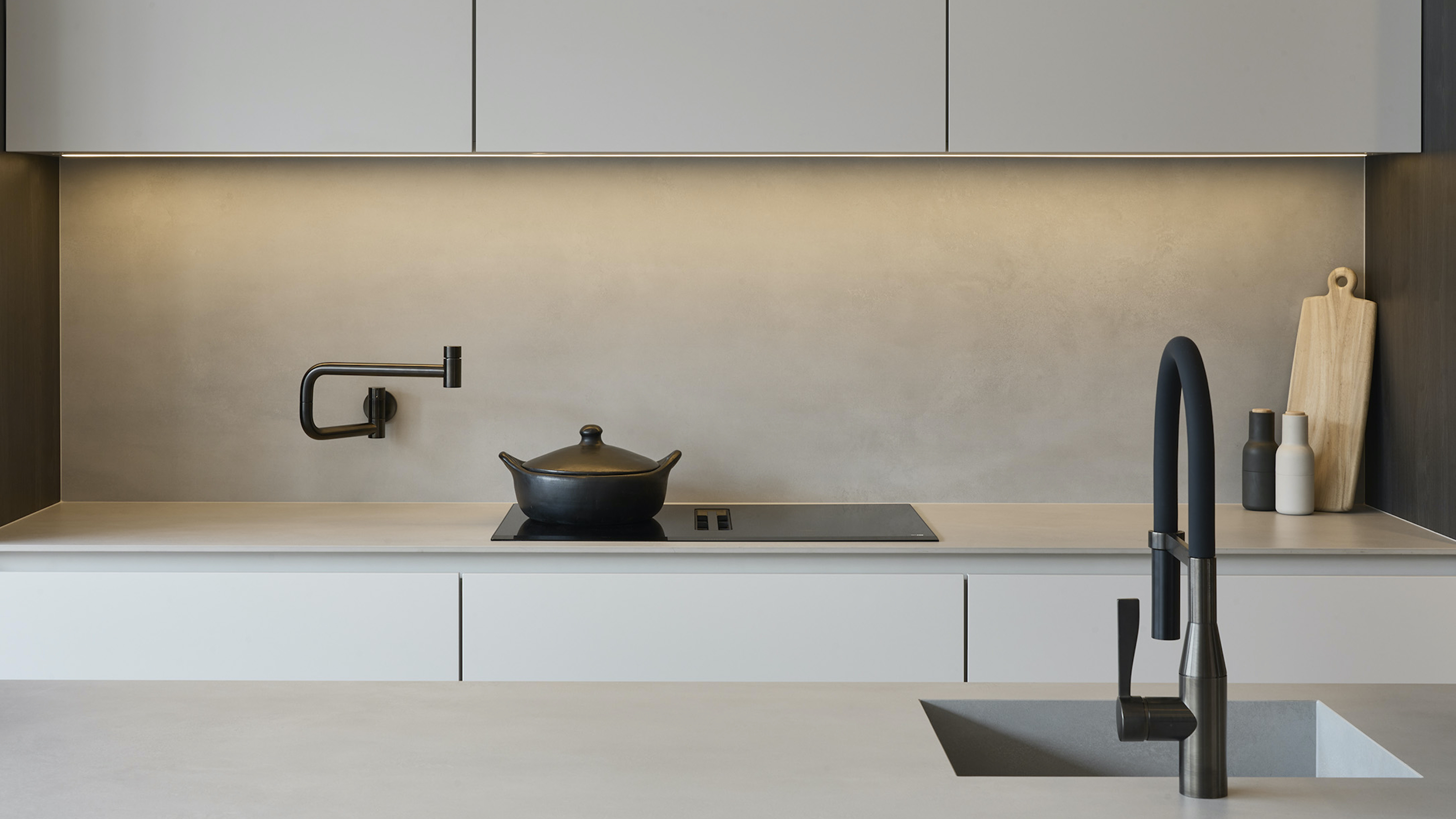 The 10 Different Types of Kitchen Taps — And the Pros and Cons of Each One to Know Before You Pick
The 10 Different Types of Kitchen Taps — And the Pros and Cons of Each One to Know Before You PickFrom sleek pull-outs to vintage bridge taps, explore 10 kitchen tap styles that mix function, flair, and a splash of cool
By Linda Clayton
-
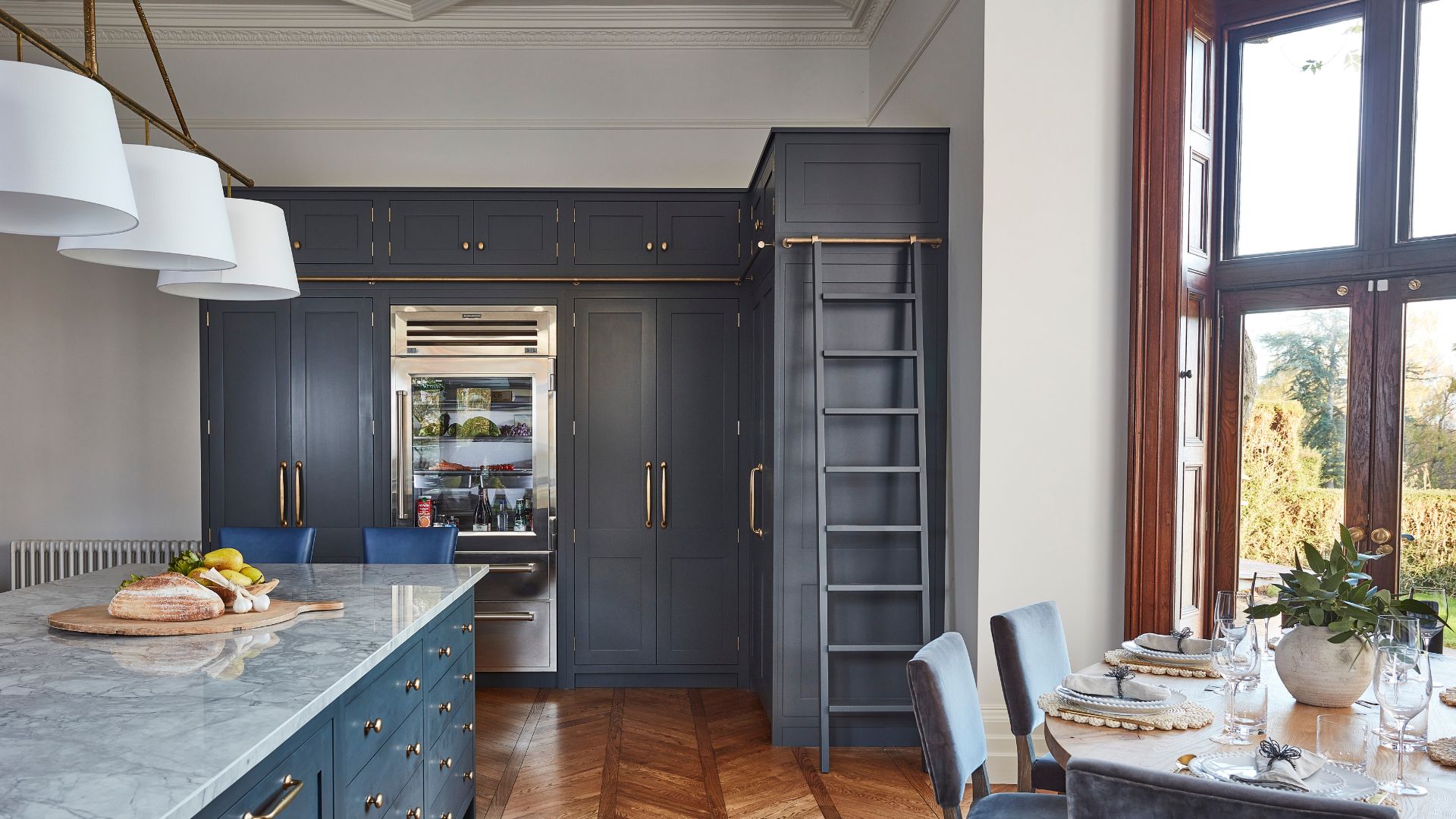 Kris Jenner’s 'All-Green' Glass Fridge Is My Organization Inspo of the Week — Here Are 5 Smart Storage Takeaways I'll Be Adopting
Kris Jenner’s 'All-Green' Glass Fridge Is My Organization Inspo of the Week — Here Are 5 Smart Storage Takeaways I'll Be AdoptingIf you're looking for fridgescaping inspiration, you might not think to look to Kris. But her all-green fridge says otherwise. Here are five tips we've learnt.
By Amiya Baratan
-
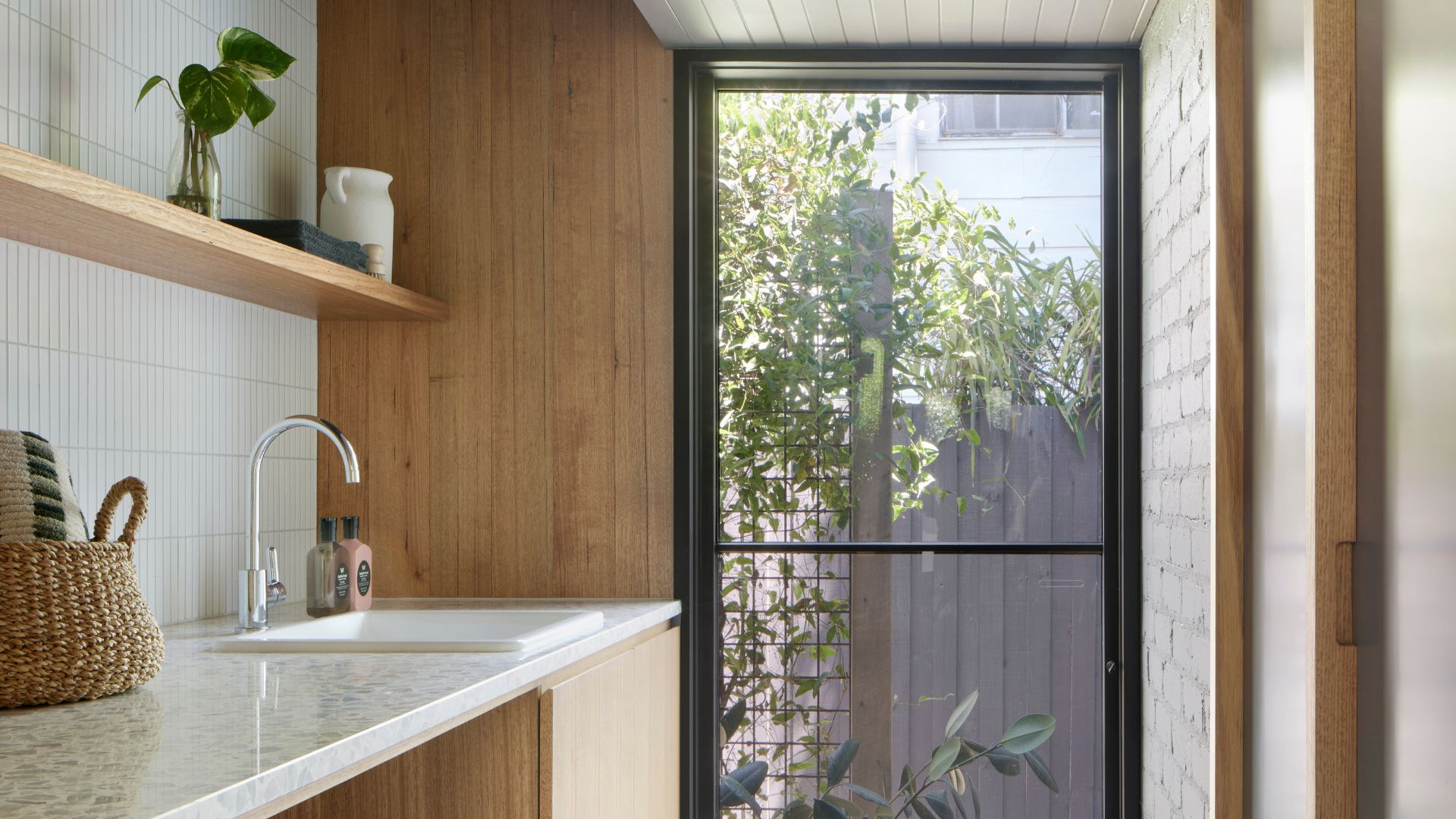 This Brilliant, Space-Saving Laundry Room Feature Makes Ugly and Clunky Drying Racks a Thing of the Past
This Brilliant, Space-Saving Laundry Room Feature Makes Ugly and Clunky Drying Racks a Thing of the PastSick of wheeling out that awkward-to-put-up drying rack all the time? This clever utility room design is something to consider for your space
By Amiya Baratan
-
 I'm Obsessing Over Brick Flooring in Bathrooms — It Might Be My Favorite Way to Bring Character to These Spaces
I'm Obsessing Over Brick Flooring in Bathrooms — It Might Be My Favorite Way to Bring Character to These SpacesLooking to create a rustic, cozy bathroom? A brick floor might just be the answer
By Maya Glantz
-
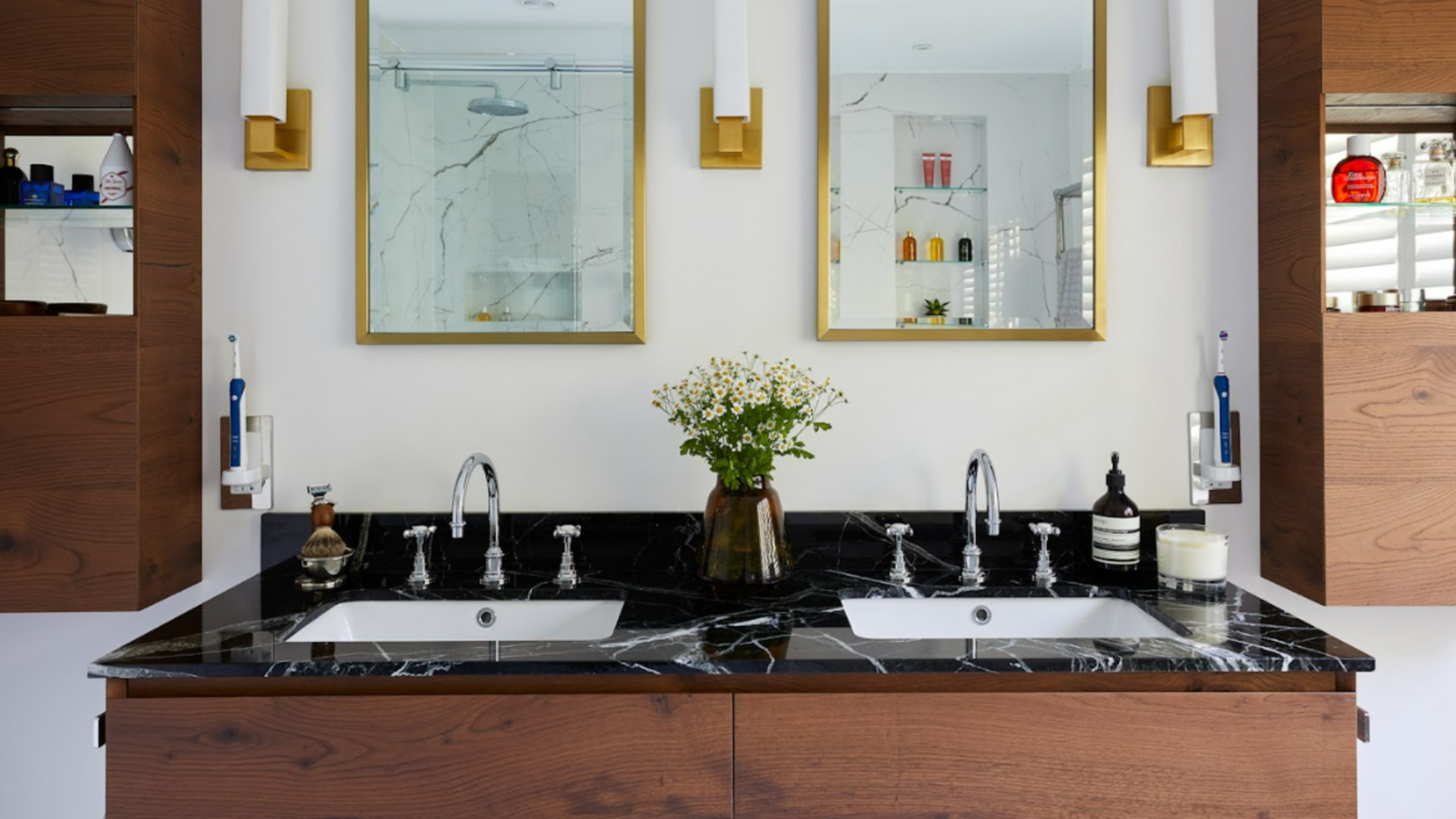 Should I Go for a Mixer or Standard Tap in My Bathroom? The Debate Might Be Finally Settled
Should I Go for a Mixer or Standard Tap in My Bathroom? The Debate Might Be Finally SettledThe experts weigh in on the choice between a standard tap and a mixer, so you know which one to choose.
By Maya Glantz
-
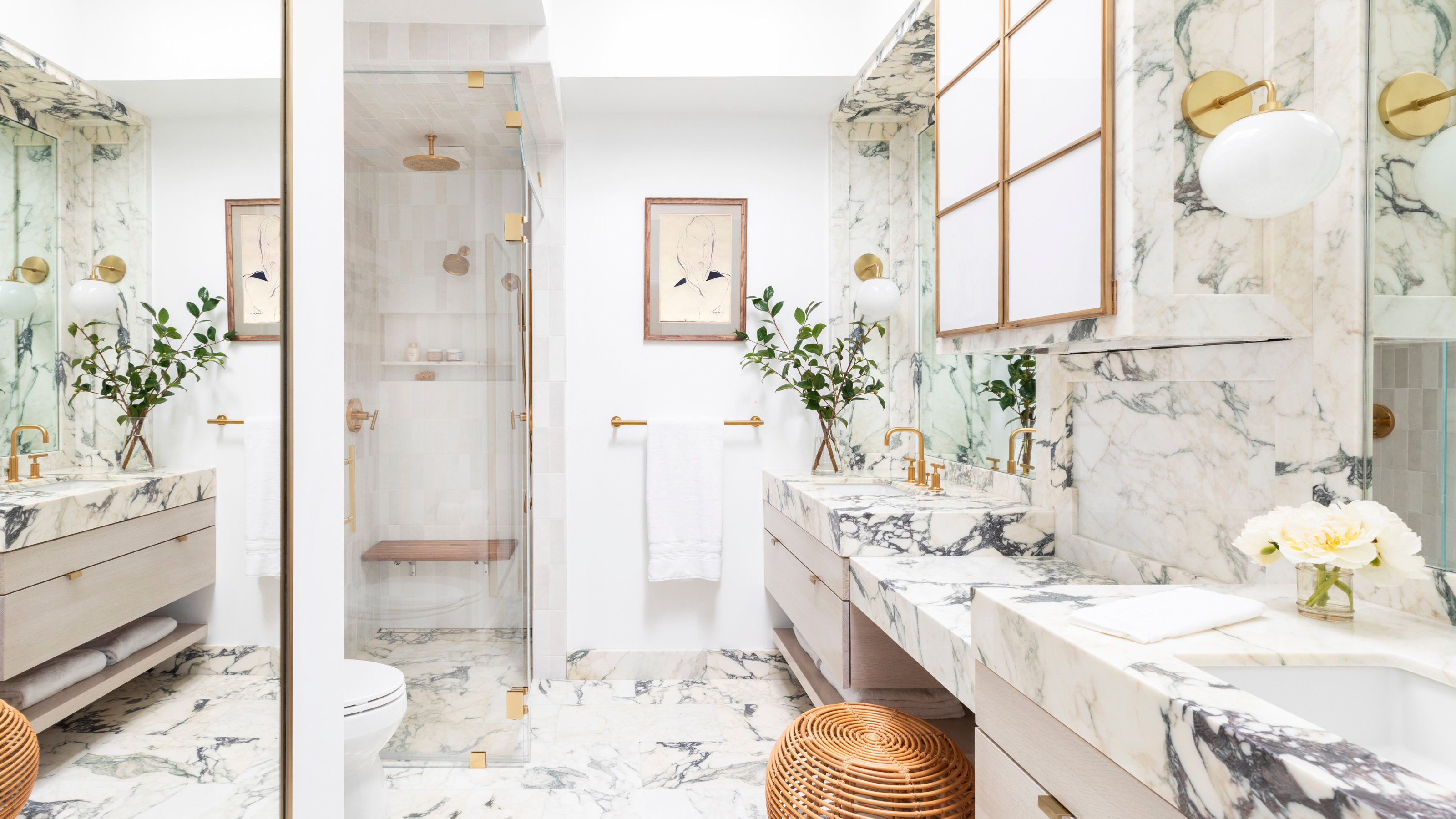 7 Bathroom Organizers That Will Change the Flow of Your Space — And Also Help You Cull Clutter
7 Bathroom Organizers That Will Change the Flow of Your Space — And Also Help You Cull ClutterKeep all your bathroom essentials contained and ditch the clutter for good with these smart ideas
By Seraphina Kyprios
-
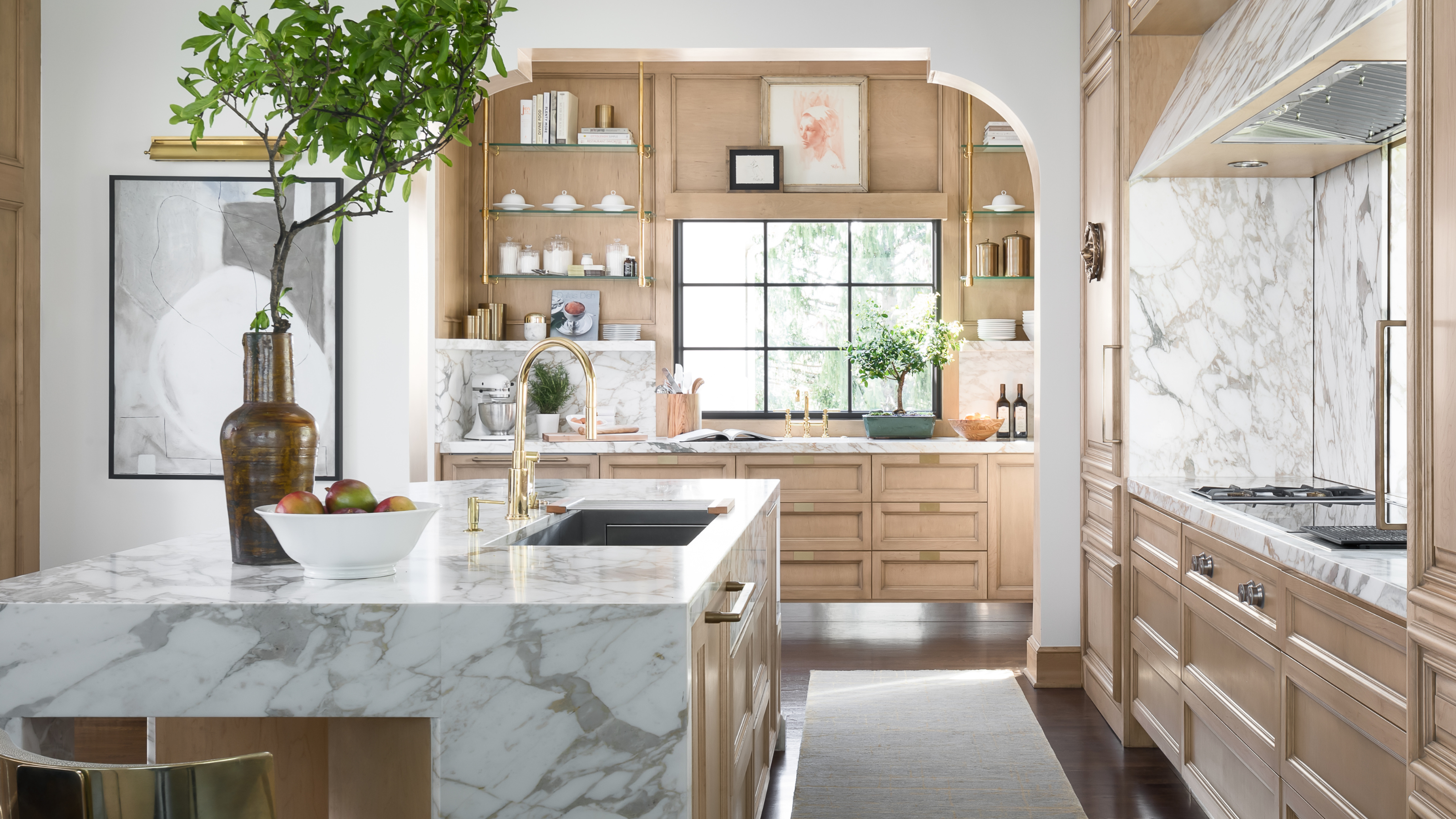 What Is a 'Dirty Kitchen?' The Hidden Feature in a Home Where All the Magic Happens
What Is a 'Dirty Kitchen?' The Hidden Feature in a Home Where All the Magic HappensThis is the hidden feature designers wish they could include in every house
By Maya Glantz
-
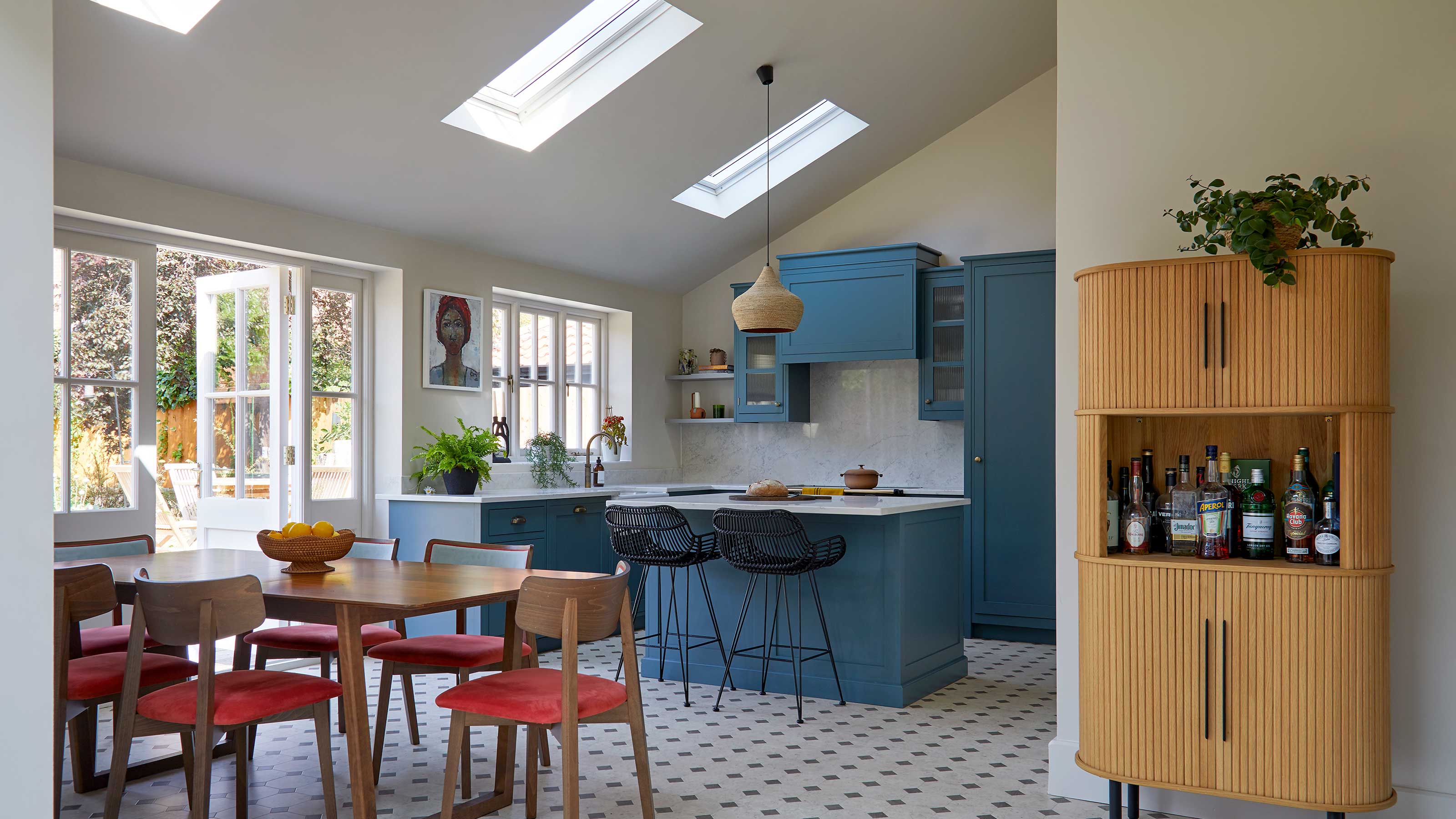 How to Make a Kitchen Extension Feel Brighter — Sometimes All You Need Is a 'Central Sun Spot'
How to Make a Kitchen Extension Feel Brighter — Sometimes All You Need Is a 'Central Sun Spot'The very best ways to make your new kitchen extension feel light, bright, and airy
By Natasha Brinsmead
